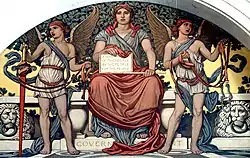Monetary authority
In finance and economics, a monetary authority is the entity that manages a country’s currency and money supply, often with the objective of controlling inflation, interest rates, real GDP or unemployment rate. With its monetary tools, a monetary authority is able to effectively influence the development of short-term interest rates, but can also influence other parameters which control the cost and availability of money.[1]
| Public finance |
|---|
 |
Generally, a monetary authority is a central bank or currency board. Most central banks have a certain degree of independence from the government and its political targets and decisions. But depending on the political set-up, governments can have as much as a de facto control over monetary policy if they are allowed to influence or control their central bank. A currency board may restrict the supply of currency to the amount of another currency. In some cases there may be free banking where a broad range of entities (such as banks) can issue notes or coin.
Commonly, there is one monetary authority for one country with its currency. However, there are also other arrangements in place, such as in the case of the eurozone where the so-called Eurosystem, consisting of the European Central Bank and the 19 European Union member states that have adopted the euro as their sole official currency, is the sole monetary authority. Some countries do not have a central bank or other monetary authority, such as Panama.
Dissent
Issues like central bank independence, effects or efficacy of central bank policies and rhetoric in central bank governors discourse or the premises of macroeconomic policies[2] (monetary and fiscal policy) of the state are a focus of contention and criticism among policymakers,[3] researchers[4] and specialized business, economics and finance media.[5][6]
Americas
Asia
- Central Bank of Sri Lanka
- Hong Kong Monetary Authority
- Maldives Monetary Authority
- Monetary Authority of Brunei Darussalam
- Monetary Authority of Singapore
- Royal Monetary Authority of Bhutan
- Palestine Monetary Authority
- Monetary Authority of Macao
- Nepal Rastra Bank
- Reserve Bank of India
- State Bank of Pakistan
See also
References
- Jahan, Sarwat. "Inflation Targeting: Holding the Line". International Monetary Funds, Finance & Development. Retrieved 28 December 2014.
- Scholvinck, Johan. "Making the Case for the Integration of Social and Economic Policy". UN Division for Social Policy and Development. Archived from the original on 18 November 2007.
- Inskeep, Steve (June 24, 2022). "The Fed's latest interest rate hike has some congressional lawmakers worried". NPR. Retrieved March 11, 2023.
{{cite web}}: CS1 maint: url-status (link) - "Fed's rate hikes likely to cause a recession, research says". AP NEWS. 2023-02-24. Retrieved 2023-03-11.
- Koop, Christel; Scotto di Vettimo, Michele (2022-09-20). "How do the media scrutinise central banking? Evidence from the Bank of England". European Journal of Political Economy: 102296. doi:10.1016/j.ejpoleco.2022.102296. ISSN 0176-2680. S2CID 252426183.
-
- Hayo, Bernd; Hefeker, Carsten (March 2001). "Do We Really Need Central Bank Independence? A Critical Re-examination". WWZ-Discussion Paper 01/03. Archived from the original on 30 June 2015. Retrieved 27 June 2015.
- Mangano, Gabriel (1 July 1998). "Measuring Central Bank Independence: A Tale of Subjectivity and of Its Consequences" (PDF). Oxford Economic Papers. 50 (3): 468–492. doi:10.1093/oxfordjournals.oep.a028657. Archived (PDF) from the original on 16 August 2021. Retrieved 18 September 2020.
- Heinemann, Friedrich; Ullrich, Katrin (3 November 2005). "Does it Pay to Watch Central Bankers' Lips? The Information Content of ECB Wording" (PDF). ZEW – Centre for European Economic Research Discussion Paper No. 05-070. doi:10.2139/ssrn.832905. S2CID 219366102. Archived (PDF) from the original on 17 August 2017. Retrieved 27 October 2017.
- Cecchetti, Stephen G. (1998). "Policy Rules and Targets: Framing the Central Banker's Problem" (PDF). FRBNY Economic Policy Review. 4 (2): 1–14. Archived (PDF) from the original on 8 August 2017. Retrieved 24 March 2018.